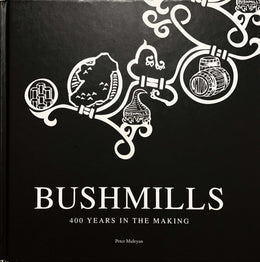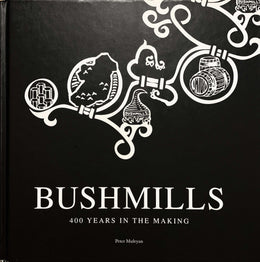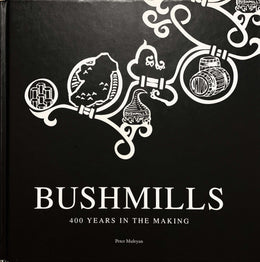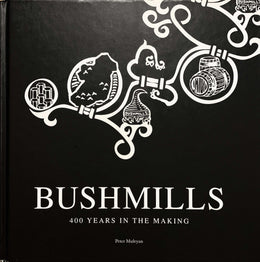
Ladders to the 2nd floor of the maltings (opposite)
“Allied Distillers was pleased Ardbeg had gone into loving hands," says Dr Bill Lumsden, Glenmorangie's Head of Distilling and Whisky Creation. "They were incredibly helpful, especially Robert Hicks, but really the whole team. I believe we were actually the second-highest bidder. We believe we got a bargain and that £4m would not have covered the value of the stock, let alone the distillery and the brand equity." Having paid £7.7m, plus many more millions on refurbishing and re-equipping Ardbeg, the distillery has been transformed from ‘pauper to prince.’
"I'm sure they would also have seen the condition of the distillery, which was badly in need of some TLC,' and that's me being extremely diplomatic"
Bill Lumsden states that "As a company we were always interested in expanding our portfolio of brands. Ardbeg did come up and it was arguably one of the very few single malt brands that truly had cult status among aficionados. One of my roles when I was working with United Distillers was conducting quality audits at Port Ellen Makings. The manager there had a nice display o f the various Islay bottles and Ardbeg was the one that always intrigued me. It was very hard to get hold of and people spoke about it in hushed whispers. It genuinely was a fantastic whisky, but the fact that you just could not get it gave it the cult status. It waspoles apart in terms of style from anything we owned, so it was very interesting to us.
"I'm sure a lot of people would have looked at the distillery and thought that it was a real niche category and I'm sure they would also have seen the condition of the distillery, which was badly in need of some `TLC,' and that's me being extremely diplomatic. We saw it as a challenge. It is an ongoing challenge to bring it up to the standard we like, but then I see it as a lifetime challenge to bring all my distilleries up to that standard."
Clearly, the most urgent priority for Ardbeg's new owners was to re-commission the distillery, and to that end, long-serving Glen Moray manager Ed Dodson was dispatched to Islay, where he spent six months getting Ardbeg up and running once again. "They chose me to go and start the distillery up again because I was the only person who had worked in a distillery with old equipment like Ardbeg had," says Ed. "I'd been in the industry since 1963, and the equipment mostly dated from the 1950s or '60s, or even earlier. No one had spent much money on the place!"

Ed was one of the three people from Glenmorangie who went over to examine the distillery before the company bought it. His first impressions were that it was very run down and needed a lot of money spending on it. "Maybe Allied would have liked to knock it down," he muses, "but that would have been expensive, and not good for their image, I suppose! I don't like seeing any distillery closed, and it was great to be there to see Ardbeg reopen and to be a part of it.
"When I went there I was working 15 or 16 hours a day, six days a week. It was the only way to get the job done. We had to replace the old cast iron hot liquor tank in the mash house, and the steam pipes, and there were lots of ‘health and safety’ issues to address. With us buying the distillery and getting it going again, we obviously had to comply with all the legislation. The mash tun really needed replacing, as it was cast iron and too low in the ground, so it was difficult to work with. But that wasn't replaced till after I'd left."
The head of the low wines and spirit still was riveted and dated from before the Second World War. It had to be replaced later, but at the time of the distillery start-up it was in good enough condition to use. The boiler had been installed back in 1965 and although Ed and his team did not have too much faith in it, they managed to make it work reliably. One washback was missing, and had to be replaced, along with two that were in particularly bad condition. The replacement washbacks came from the silent Hillside distillery near Montrose, but they were too large for use at Ardbeg, and had to be cut down to fit.
"There were two guys still employed at Ardbeg," notes Ed Dodson, 'Wardle and Ruari Macintyre, and I initially took on two who had previously worked there. One was Alex Livingstone, and the other was The Gow, both of whom are still there. We mashed for the first time on 16 June 1997, and when we started to produce, I didn't expect the first spirit to be any good because the washbacks were sour. They'd had water standing in them, and it was very peaty water at that. But it was actually pretty good, and once we really got it running it was very good. I was surprised by just how fruity it was and how that helps to mask the smoky tar notes from the heavily peated malt. We got the first spirit at 2am on 20 June." The distillery ran until the first week in August then closed down for the ‘silent season,’ as was usual on Islay. That provided the opportunity to do some more work on the plant, though Ed Dodson recalls the difficulty of obtaining the services of specialist tradesmen on the island, and many were brought from the mainland, which took time as well as costing money.
Bill Lumsden says "We operated it in 1997 just to tuck some stock under our belts, but then we had to close down to start the first phase of repairs as the distillery simply would not have gone on. We replaced some copper work, pipe work and electrics which just weren't working. At this time I was Glenmorangie distillery manager. We went over and threw our tuppence worth in. On this visit I was intrigued by a shoe box stuck to the wall which I thought was some kind of local good luck symbol. Eventually I asked one of the guys about it and he went over and pulled it off, revealing an exposed electrical junction box! It is that sort of thing we saw about the plant, so to say it was held together with chewing gum, Sellotape and string was not too far removed from the truth.
"The Islay people were so friendly, and everyone was dead keen to see the place lip and running again"
Duncan Logan had previously served as Ardbeg brewer for 35 years, and he was a great asset as he knew so much about the running of the distillery and its equipment, helping out when there were problems o r queries. Ed Dodson notes that "The Islay people were so friendly, and everyone was dead keen to see the place up and running again. Co-operation with the locals generally was fantastic. I enjoyed my six months there, though I didn't have much of a social life as I was working so hard. I stayed in a chalet at the Machrie Hotel, and if you were in the hotel to eat or for a drink, and guests found out you were a distillery manager, you'd never get to bed. You'd be up drinking till 2am, and that just wasn't really on. Overall, it was quite an honour to be asked to go over and do what I did, and I'm proud to have played my part in it all."
Ed Dodson's assistant manager at Glen Moray was Stuart Thomson, and with Ardbeg in production once again and Ed heading back east, the decision was taken to send Stuart on a six months secondment to run the recently-acquired distillery.
As Stuart recalls, "When I first visited Islay it was to see Ardbeg, prior to a six months spell there. I went to Ardbeg on the understanding I could go back to my job in Elgin at the end of the six months if I didn't like it. Being a whisky person it was fantastic driving from Port Ellen, passing Laphroaig and Lagavulin - such great Scotch whisky names. When I got to Ardbeg I stopped my car at the top of the road and let my collie dog out for a call of nature. I looked down on the distillery and even from that distance I couldn't believe the state of the place. The dog took one look at the distillery and instead of getting back in the car he headed off in the opposite direction! I couldn't really blame him. I wondered just what I'd let myself in for.
"We found quite a lot of empty casks, which had just leaked their contents over time, as they'd never been checked for years"
"I'd not been married long and my wife Jackie was pregnant, so I had gone over by myself and stayed for three days. The distillery was a mess, but Islay has this mystique about it, and after three days I'd already been hooked. I went home and told Jackie Ardbeg was `lovely.' A little lie. When she actually saw it for the first time she looked at me and said "You lying *******!
"The warehousing was in a horrific state. Number 3 had a big hole in the roof, despite having stock in it. We had to move it all out to other places before we could start repair work. We found quite a lot of empty casks, which had just leaked their contents over time, as they'd never been checked for years."
During Stuart's tenure as manager the distillery plant was progressively upgraded, with the installation of a new mash tun and a replacement spirit still. Bill Lumsden notes that "During the second major shut down we replaced the mashtun. The marketing department wanted t o keep the old-fashioned `rakes and plough' mashtun. However, as someone who had worked with one of these older style mashtuns at my first distillery and as a scientist on the technology of mashing I was equally adamant that we should not keep it. So we reached a compromise where I replaced the guts of the mashtun with semi-lauter steering gear and kept the old cast iron plates which were fitted over the new stainless steel shell."
Inevitably, expenditure is ongoing at any distillery, and as Stuart notes, "Apart from anything else, you have to paint the outside two or three times a year because moisture works its way out of the stone. That costs around £20,000 a year alone. People who had lived in Ardbeg all their lives never expected it to come back to life, and what we did as a company by reviving it stood us in good stead locally."
A range of new and attractively packaged Ardbeg single malt bottlings was gradually developed in order to boost sales and enhance the brand image (see Chapter Six), while a great deal of attention was also focused on creating an attractive and welcoming visitor centre. Accordingly, one of the disused malt kilns was converted into the Old Kiln Café, which opened in 1998, providing a rare opportunity for visitors to obtain refreshments while visiting an Islay distillery. Before long, the Ardbeg cafe was one of the favourite eating places on the island for both visitors and locals alike. The kiln conversion also housed the distillery shop, acting as a showcase for Ardbeg bottlings, along with branded clothing and gift items.
The café and shop is the domain of Jackie Thomson, whose initial impressions of Islay were coloured by an event taking place far from the Hebrides, and one that has become highly significant in modern history. "I first came to Ardbeg the day that Princess Diana died," she says. "August 1997. Stuart was already there and he drove me a1i over, showing me Islay. It seemed to take so long to get anywhere—I thought it was a much smaller island than it turned out to be.
"There was a phone booth in the corner of the old mash house, so I phoned my mum to tell her all about the place, and she was very quiet. She told me about Diana and the car crash in Paris. That unfortunate event will always be etched in my mind with the day I arrived on Islay. I had to finish my season working in the Glenmorangie distillery visitor centre, before I could join Stuart at Ardbeg to take on the role of visitor centre manager. Stuart had been assistant manager under Ed Dodson at Glen Moray distillery from 1993 and also worked at Glenmorangie for 12 years before that, where his father was assistant manager. I started work at Glenmorangie visitor centre and we put together the new one in 1997/98. We got married while we were at Glenmorangie."
The Old Kiln Café has been a tremendous success, bringing additional focus to this part of the island and in a small way, helping to restore a sense of community. Having spent over 20 years on Islay, Jackie is wholeheartedly committed to her role there and is sanguine about island life, summing it up as "On Islay your life is played out with a microphone. I t could just be a quiet song, but instead it's a disco! I don't mean that in a bad way —it's just the way it is on an island."
In 2004 Ardbeg experienced yet another change of ownership, when the Macdonald family, owners of Glenmorangie plc, sold the company, including Ardbeg, Glenmorangie and Glen Moray distilleries, to the LVMH Group for £300 million. LVMH (Louis Vuitton Moet Hennessy) has its headquarters i n Paris and specialises i n luxury brands, including Moet and Chandon, Krug and Dom Perignon champagnes, Hennedy Cognac and wines from a number of New World vineyards.
To the dismay of many Ardbeg fans, August 2006 saw Stuart Thomson announce his intention of resigning from his post as distillery manager at Ardbeg
The purchase of Glenmorangie by LVMH was followed by the release of the two most exclusive and expensive Ardbeg presentations of all time, and while in keeping with the ethos of LVMH, Ardbeg's global brand director Hamish Torrie is keen to point out that "The 1965 bottling and the Double Barrel releases were definitely not influenced by LVMH's purchase of Glenmorangie. Both ideas had been on the slate long before LVMH came along. They have no input into the distilleries and the whisky selection. As far as Ardbeg's concerned they just say ‘keep going as you are.’”
To the dismay of many Ardbeg fans, August 2006 saw Stuart Thomson announce his intention of resigning from his post as distillery manager at Ardbeg, subsequently moving back to the mainland to pursue other projects. Jackie Thomson continued in her role as visitor centre manager, while Jura distillery manager and Ileach Mickey Heads was recruited to take Stuart's place. Mashman and stillman Ruaraidh Macintyre (`Mackie') says "We were all apprehensive about getting a new manager, but it's great that Mickey is a local. He's got the best interests of Ardbeg and the island in mind."
"I was cock-a-hoop about getting Mickey Heads as the new manager"
Bill Lumsden goes so far as to say "I was cock- a-hoop about getting Mickey Heads as the new manager. You know all the managers and the ones you hope will apply for the post and Mickey was absolutely at the top of my list. It was a wrench for him to leave the Isle of Jura but we thought he would be perfect for the position and he has already done a fantastic job there. The distillery is as buzzing as I can ever remember it. He has a really long period of experience and history, so any of the little production problems just don't faze him. He has taken the distillery by the scruff of the neck and re-invigorated it."
"The whisky's good—so you don't need to change the place," declares Mickey Heads. "I'm really just carrying it all forward. I see myself as just a caretaker. Somebody will always come along after you, and maybe do it differently. So you just do it as well as you can, and with as much passion as you can."
Stillman and mashman Alistair Johnston ('Asha') says "Stuart and Jackie put Ardbeg back on the map. Their contribution has been massive. Jackie's one of the hardest workers I've ever seen. She's got so much passion and enthusiasm."
Mashman Archie McKechnie (‘Yogi’) notes that "The place looks so much better now than it did when I came here. You wouldn't have wanted to be working here when Allied had it," and stillman and mashman Malcolm Livingstone (‘Azza’) echoes that point. "The place is beyond recognition now compared to what it was like before it reopened," he declares. "Doors were hanging off and everything was dirty and untidy, with weeds everywhere. Now it's all white and clean and tidy."

No.1 maltings and kiln being refurbished in 1997
Written by Gavin D Smith & Graevie Wallace
The text is an excerpt from "Ardbeg: Heavenly Peated" (pp. 59 - 65), written by Gavin D Smith & Graevie Wallace, published 2018 by Hogback Publishing.







